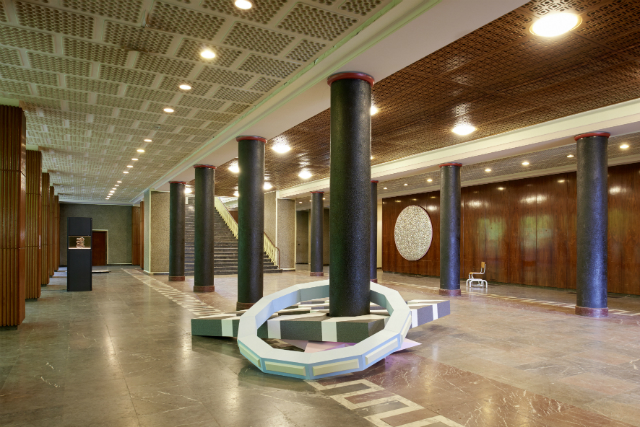
A Tommy Støckel sculpture in the main hall ground floor of Funkhaus Berlin’s Block B. Image credit: Michael Klaus
Funkhaus Berlin
Nalepastrasse 18-50, Berlin
On view until September 20
Curated by Janine Eggert, Sibylle Jazra, Marte Kiessling and Christopher Sage
Artists: Stefan Alber, Alexandra Baumgartner, Ulu Braun, Jonas Burgert, Phil Collins & Ivana Kličković, Eli Cortiñas, Janine Eggert, Christian Falsnaes, Dennis Feddersen, Wolfgang Flad, Nadja Frank, Jay Gard, Ingo Gerken, Hannah Gieseler, Anna Lena Grau, Amélie Grözinger, Hannes Gruber, Emma Grün, Stef Heidhues, Anton Henning, John Isaacs, Christian Jankowski, Florian Japp, Sibylle Jazra, Michael Johansson, Annette Kelm, Marte Kiessling, Caroline Kryzecki, Anja Langer, Bjørn Melhus, Alexej Meschtschanow, Zoë Claire Miller, Anne Neukamp, Lawrence Power, Thomas & Renée Rapedius, Janne Räisänen, Haleh Redjaian, Philipp Ricklefs, Alona Rodeh, Julian Rosefeldt, Christoph Rothmeier, Christopher Sage, Michael Sailstorfer, Sonya Schönberger, Eli Skatvedt, Yorgos Stamkopoulos, Tommy Støckel, Despina Stokou, Chryssa Tsampazi, Jorinde Voigt, Christof Zwiener
When I’m in Berlin, I often think about the city’s most oft told quote, “Berlin is a city that never is, but is always in the process being.” Art critic Karl Scheffler penned those words over 100 years ago and they still seem relevant.
It’s a city that has had to adapt to unfavourable circumstances: the end of the Weimar Republic, the rise of the Third Reich, the postwar allied occupation that led to building the wall separating East and West. The wall was a stark embodiment of the foundational clash between communism and capitalism: the East had its monumental Stalinist architecture, the West its modular concrete utopias. Post-reunification Berlin saw the slow merging of these separate ideologies, and the enduring spatial fiction is that of a city always under construction.
During Berlin Art Week, there are two curatorial projects exploring these psychogeographic angles. STADT/BILD (Image of a City), is a cooperative project between four of Berlin’s leading institutions focusing on the city’s future. References to Barthes (Berlinische Galerie’s Xenopolis), Allan Kaprow (National Galerie’s Fluids: A Happening) and Guns N’ Roses (KW Institute for Contemporary Art’s Welcome to the Jungle) abound, tangling an ephemeral yarn about finding a sense of belonging in jagged concrete landscape.
But Arcadia Unbound, an independent project curated by four Berlin-based artists in a former central GDR broadcasting station on the outskirts of the city, taps into the still lingering ostalgie (“nostalgia for the East”) that looms largely in the collective unconsciousness of many wahlberliners. The fall of the wall, after all, coincided with the fall of communism, leading to the demolition of so many East German government buildings. Over drinks one night in Kreuzberg, a local gallerist moaned to me about how the Friedrichshain neighbourhood is one of the few areas where you can experience those distinctively wide boulevards and Soviet “wedding cake” style buildings. Arcadia Unbound, with the involvement of over forty international established and emerging artists, truly gives a real sense of how artists respond to the city’s past, and in particular, it’s ruins.
To get to the Funkhaus Berlin, you have to cross the Spree, the river that winds through the heart of the city. Off of Köepenicker Chasse, past the looming industrial blue cranes and the high wooden gates of the Sisyphus club, the imposing Bauhaus-soviet facility was once the “BBC of the DDR”. At one point, over 3,500 people worked in this recording complex; there was even a sauna, ice cream parlour, grocery, and canteen. It was a city within a city, and given the fact that there was one Stasi informer for every 6.5 East-Germans, completely wired. (Unsurprisingly, the classic Cold War drama, The Lives of Others, was filmed here.)
In the main hall of Block B, the space’s imposing materiality — black painted columns, marble floors, mahogany wall paneling — is countered by futurist sculptural works. Amidst the GDR grandeur, West German modernism —informed by consumerism as much as idealism—is positioned in dialog with the Soviet architecture.
For example, a fractal styrofoam Tommy Støckel sculpture lays on the floor by the building’s entrance. It resembles a deconstructed Will Alsop geometric form, but is awkwardly stacked around the column in such a way that the individual pieces looked like they might topple and fall. It suggested a fragility of the new and old structures, speaking to the city’s habitual destructiveness. Old buildings are torn, but the mythic modern — like the promise of a new airport — sometimes never get off the ground.
Further along, there’s a call and response with the silver origami relief-like surface of a hanging Amélie Grözinger work, resembling the flattening of trash compacted Jetson’s rocketship. Tucked just under the spiral staircase, on the reddish-brown marble, is an Anja Langer relief; the blonde-on-blonde effect of its space rock fissure on a flooring made from New Reich Chancellery-gathered limestone evokes an excavated continuum.
Arcadia Unbound’s curators give great care in how they situated certain works throughout the facility. In one of the recording halls large enough to accommodate ensembles, delicate paper lantern-like vessels by Thomas and Renée Rapedius were the ghostly apparition stand-ins for the symphony or choir that likely once recorded there. A first floor Marte Kiessling installation — spider plants in a naive hand-built ceramic cliff range with small GPS screens employing a first-person perspective into a lush Second Life-like environment — face large windows looking out onto the Spree, deliberately layering the artificial onto the real. Toward the end of Block B’s curved hallway, hanging from the ceiling, was a Wolfgang Flad wooden exoskeleton sculpture, bringing to mind a ossuary display.
Tensions were most prevalent in the installations curated in the recording halls, though their impact was owed to where they were situated — these halls, with their old growth timber walls, are astoundingly grand. In one of the recording halls, Christoph Rothmeier’s broken guitars looked like the collected remains of Pete Townsend’s smashed pile; the remains leaned against the cushioned audience chairs, emitting a tonal soundscape that inspired certain viewers to make their own sounds — hand claps, a child’s wacking of a plastic baseball bat— in response. In the other recording hall, Dennis Feddersen’s spindly steel beams and Sibylle Jazra’s rough-shodden assemblage of mass-manufactured furniture pieces brought to mind the anarchy of imperfections, the ever-growing garbage pile that can be everyday objects.
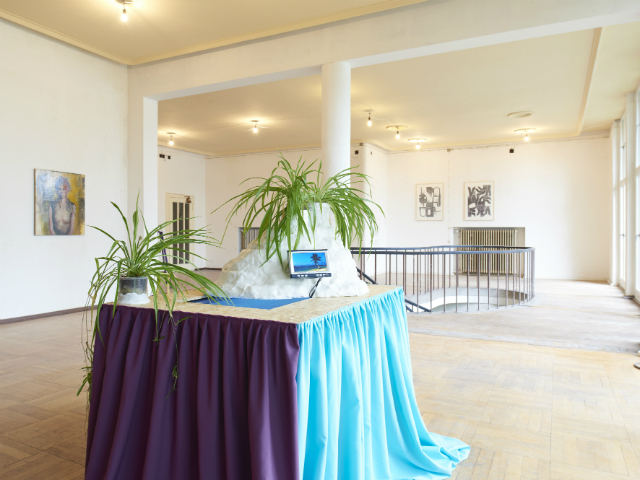
A Marte Kiessling installation on the first floor of Block B, near the spiral stairway. Image credit: Michael Klaus
Consistently, attention was given toward objects, and the processes enacted upon them. On a microcosmic scale, the sum of the works spoke to the transformations and mutability possible in a ruinous atmosphere. In the same curved hallway, a re-built Jay Gard record player spins a big-hearted 1980s power ballad, it was like hearing a smuggled bootleg from the West. Nearby, Hannah Gieseler stacks a precarious totem to life’s essentials: an upside down magnum of red, a block of cheese, a piece of driftwood, a spindle of yarn.
Further, near a spiral stairway, Ivana Kličković evoked a different sort of survivalism — a flat screen on maize carpet plays a karaoke version of Phil Collins’ “In The Air Tonight”, the visuals seem to be broken transmissions from a gay club of that era. The contrast between the sinuous movements of taut muscles and the hanging silkscreen of a woodgrain mountainous landscape on the wall suggests how unsurmountable the climb toward hedonism and release can be reachable. The work was positioned near a long stretch of bay windows, facing the Spree, suggested there may be many different routes towards one’s utopic escapist visions.
On the Kultursaal first floor of the Block C building, this takes an epic scale: two large-scale minimalist Florian Japp sculptures recall the multi-coloured water pipes you see criss-cross the city landscape. The sculptures deliberately frame the stage’s Christian Jankowski video work, a wry documentation of an art consultant speaking to Airbus employees about the ROI possibilities of a corporate art collection. (It turns out this was staged by Jankowski during the Airbus-sponsored Finkenwerder Art Prize ceremony he was awarded last June.) Here, the processes of commerce and commodification are laid bare; the transactional exchanges of space and objects are explicitly clear. Empty buildings left to rot eventually become venues for street food pop-up markets and large-scale exhibitions in the grand scheme of revitalization. But until it’s capitalist makeover is complete, the Funkhaus Berlin remains a unique site of discourse between the loaded built environment of the East and the booming culture of the city’s present.

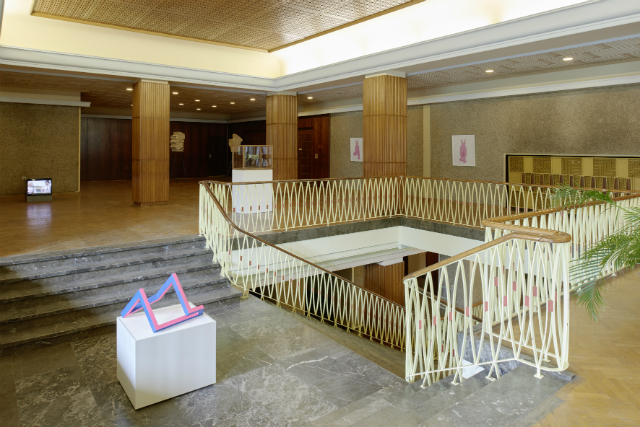
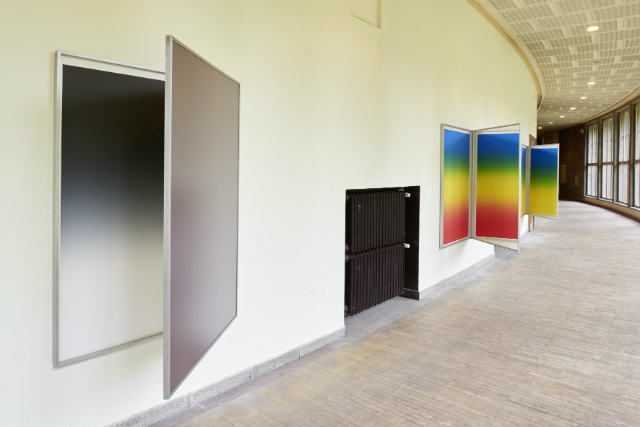
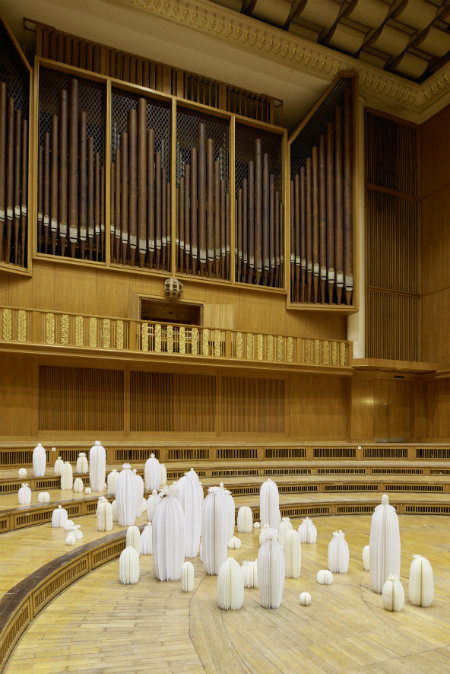

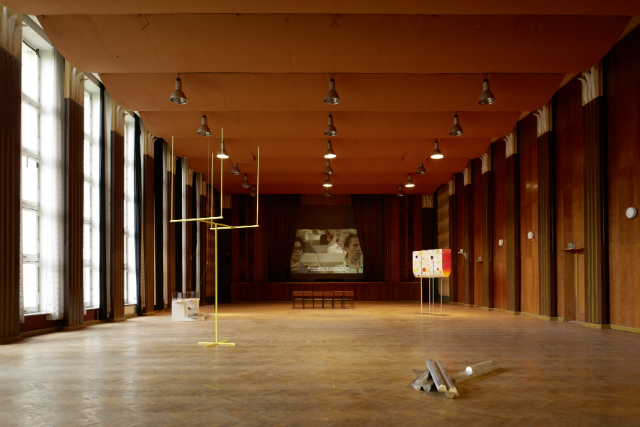

Comments on this entry are closed.